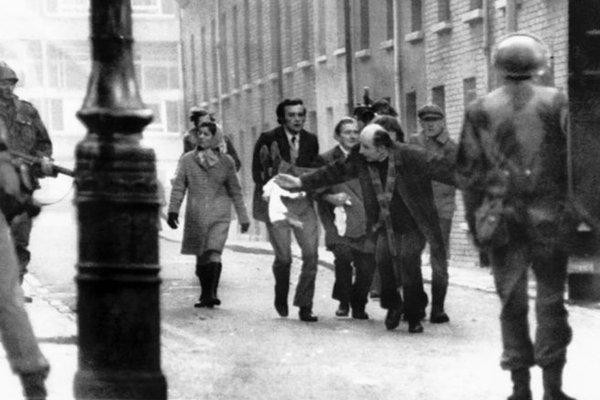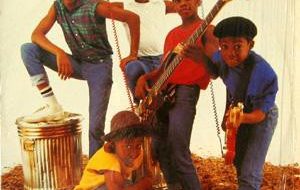
Since the 15th Century, Western Europe has played host to one of UK?s most bloody and traumatic wars, which is the enraging conflict between Northern Ireland and England. From all the bloodshed and violence, which has occurred since then there is one period, which stands out. Simply, labeled ?The Troubles? it tells a bloody tale of a three decade conflict, which took place between Irish nationalists and Irish unionists from the 1960?s till the 1990?s. Although this bloody conflict was ended with the ?Good Friday Agreement?, it?s legacy was so traumatic that it helped influence some of the biggest protest songs to have come out of the music industry.
Bloody Sunday
?Bloody Sunday? was a term given to an incident to an incident, which took place on 30th January 1972 in Derry, Northern Ireland where British Soldiers shot 28 unarmed civilians who were peacefully protesting against Operation Demetrius. Out of all the people who lost their life that day; Thirteen were killed outright, while another man lost his life four months later due to injuries. Many of the victims who were feeling the scene were shot at point blank range, while some who were helping the injured were shot. Other protesters were injured by rubber bullets or batons, and two were run down by army vehicles.
This massacre is reported to have the highest number of people killed in a single shooting incident during the conflict. The first person to have addressed these events musically was John Lennon who composed ?Sunday Bloody Sunday? and released it on his third Solo album ?Sometime In New York City?. His version of the song directly expresses his anger towards the massacre, which also shows his political viewpoints in the complexity of the longstanding problems that exist between the Irish & British. When music critics tore his song apart and said that it wasn?t strong enough to address the problem at hand he was quoted saying to NME Journalist Roy Carr
?Here I am in New York and I hear about the 13 people shot dead in Ireland and I react immediately. And being what I am I react in four-to-the-bar with a guitar break in the middle. I don?t say ?My God, what?s happening? We should do something.? I go ?It?s Sunday Bloody Sunday and they shot the people down.? It?s all over now. It?s gone. My songs are not there to be digested and pulled apart like the Mona Lisa. If people on the street think about it, that?s all there is to it.? [1]
U2?s Sunday Bloody Sunday
Although U2?s version of the song arrives as a single precisely 11 years, 1 month, 21 days since the incident, the catalyst that inspired the band to pay tribute to the fallen with this song came because of a confrontation with IRA (Irish Republican Army) supporters in New York City.
U2?s ?Sunday Bloody Sunday? version of the song is designed to transport the listener into 1970?s war-torn Ireland where your present watching the horror unfold as an observer. Their version of accounts are instead inspired by their passive-aggressive approach to the situation with verses like ?How long must we sing this song??, which signifies their anger towards the authorities approach to the situation. However, that verse is immediately followed by ?Cause tonight, we can be as one, Tonight?, which signifies that the door is still open for a peace treaty.
They also draw inspiration from the world famous picture of Edward Daly being spotted protecting a group of survivors attending to an injured boy by waving a blood stained handkerchief in the peace.
Song Structure
The success of the song can also be attributed to the structure, which is a simplistic 4/4 time signature that?s driving the tempo of the song (2). The song begins with a militaristic drum-beat that was composed by Larry Mullen Jr., which was recorded in a staircase of their Dublin recording studio because producer Steve Lillywhite was trying to get a full sound with a natural reverb. The beat is closely designed to resemble a military band due to the synchronisation of the drum pattern, snare drum & electric violin (2). This is further accompanied by The Edge?s stellar guitar work, which comprises of a
distinctive descending guitar riff, with repeating arpeggios. Rolling Stone later described this riff as the ?bone-crushing arena-rock riff of the decade? (3). The minor-chords used in this riff is a Bm?D?G chord progression, which helps establish the passive character of the song so far.
As the song progresses, the aggression is released as Bono declares ?How long? How long must we sing this song??, which is matched as The Edge?s switches to a more aggressive major-chord pattern. The aggressiveness of the song is further cemented with an aggressive bass-drum that appears on every beat before launching into the chorus where Adam Clayton?s bass guitar joins in. As this is happening The Edge provides stellar backing vocals by communicating ?Sunday Bloody Sunday? to the listener via a harmonic imitative echo. As the song further progresses into the next section, the snare drum is muted along with the guitars, which draws it?s inspiration from the raw aggression seen in the song?s verses and gives the song a more uplifting structure.
Lyrics
The lyrics of the song both reference either Bloody Sunday event that took place in 1920 & 1970 respectively but focus more on the observer who is horrified by the cycle of violence and is inspired to act. This change in approach is a drastic change from an early version of the song, which contained lyrics like ?Don?t talk to me about the rights of the IRA, UDA.?. Instead the band decided to change the lyrics to showcase the atrocities of war without taking sides. Instead they chose an opening line, which would resonate highly with young people who would know nothing about these troubles. There is one biblical verse, which is put forward in the lyrics, which is Matthew 10:35 (?mother?s children; brothers, sisters torn apart?) and bring a twist to 1 Corinthians 15:32 (?we eat and drink while tomorrow they die?, instead of ?let us eat and drink; for tomorrow we die?).
Finally the song finishes by declaring to the Irish that they need to stop fighting each other and just claim the victory ?Jesus won?on [a] Sunday bloody Sunday.?
Live History
The song has been played more than 600 times by the band since it?s inception in 1982 (4). Due to misinterpreted lyrics Bono had to clarify the meaning to the audience by stating ?This is not A Rebel Song, This song is Sunday Bloody Sunday?. While this song has been a live staple for the band they omitted it from their set-list for a while because of one such performance where the true emotion of the song came out and they knew they could never replicate that emotion ever again. This happened while they were shooting their 1998 rockumentary ?Rattle And Hum? on 8th November 1987 at the McNichols Sports Arena in Denver, Colorado. On this version Bono goes on a rant mid-song to condemn the Remembrance Day Bombing that had occurred earlier that same day in the Northern Irish town of Enniskillen. The rant went as follows:
?And let me tell you somethin?. I?ve had enough of Irish Americans who haven?t been back to their country in twenty or thirty years come up to me and talk about the resistance, the revolution back home?and the glory of the revolution?and the glory of dying for the revolution. Fuck the revolution! They don?t talk about the glory of killing for the revolution. What?s the glory in taking a man from his bed and gunning him down in front of his wife and his children? Where?s the glory in that? Where?s the glory in bombing a Remembrance Day parade of old age pensioners, their medals taken out and polished up for the day. Where?s the glory in that? To leave them dying or crippled for life or dead under the rubble of a revolution that the majority of the people in my country don?t want. No more!?
References
(1) Blaney, J. (2007). Lennon and McCartney: together alone : a critical discography of their solo work. Jawbone Press. pp. 65, 68. ISBN 9781906002022.
(2) Commercial sheet music for ?Sunday Bloody Sunday.? Universal-Polygram International Music Publishing. Distributed by Hal Leonard Publishing. ISBN 0?7119?7309?1. Retrieved 12 December 2006.
(3) Connelly, Christopher (19 January 1984). ?Under A Blood Red Sky Review: U2: Review?. Rolling Stone. Archived from the original on 19 April 2008. Retrieved 17 May 2010.
(4) U2-Vertigo-Tour.com. ?U2 on Tour ? played songs: Sunday Bloody Sunday


